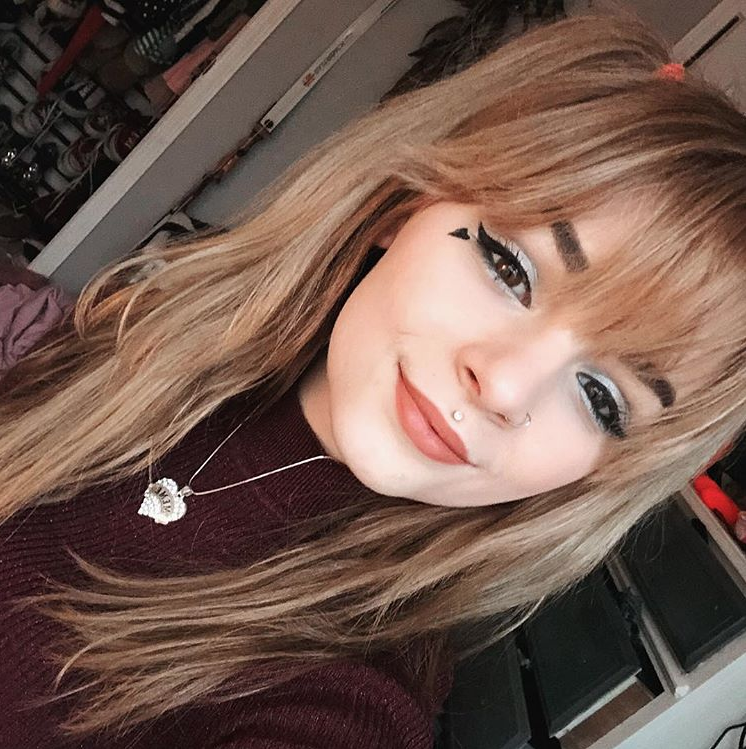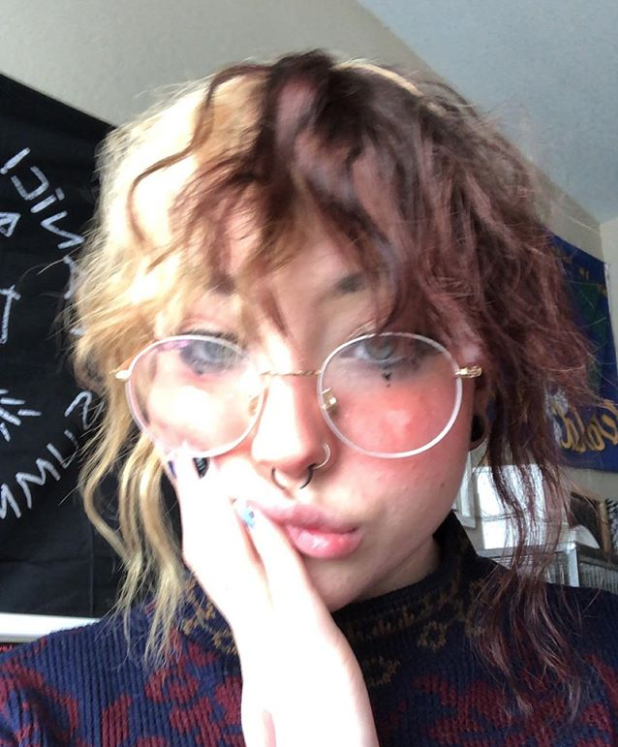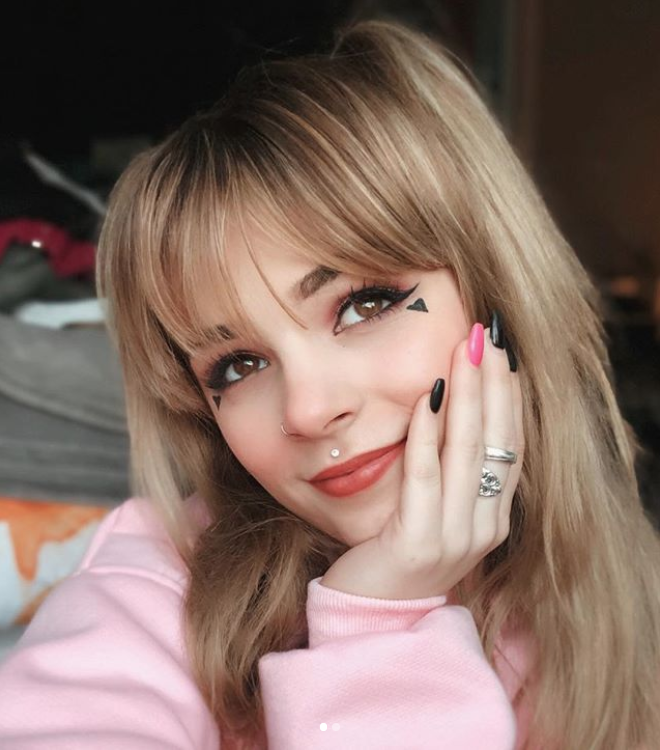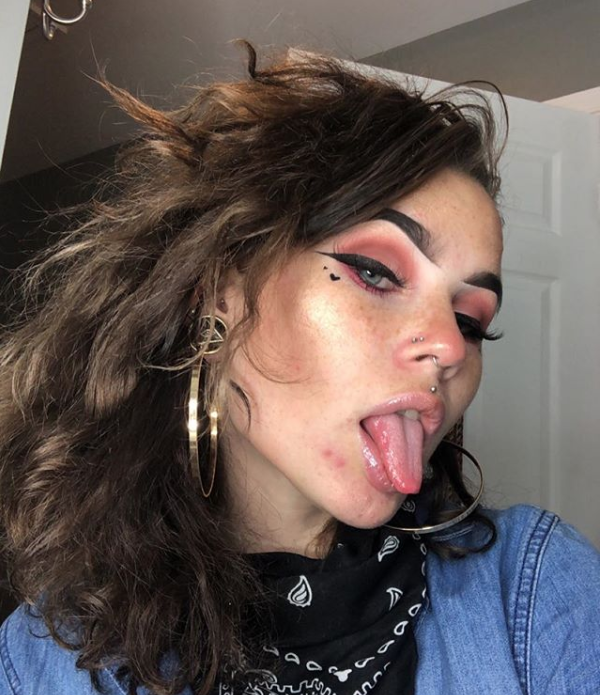The TikTok opens on a teen girl with half-green, half-black hair, a compact of pink blush in one hand and a brush in the other.
“Don’t worry, I’m not gonna do what everyone thinks I’m gonna do,” says the voiceover, a clip from the 1998 movie Half Baked.
As she mouths along with the words, she cakes the blush on her cheeks and her nose, making her look like she spent too long in the sun.
If you haven’t spent time on the TikTok app, none of that makes any sense. But for those in the know, it’s a perfect encapsulation of egirls — a new kind of cool girl who was born and lives on the platform. She’s funny, she’s cute, she’s totally ’90s, and she knows exactly how to play with expectations.
TikTok lets users make videos up to 15 seconds long, set either to popular music or sounds they upload themselves. That’s why it made a lot of sense when TikTok merged with the app Musical.ly in 2018. TikTok’s parent company, ByteDance, is currently considered the world’s most valuable unlisted startup. It now has more than 800 million downloads worldwide.
At first blush, TikTok might look like a lip-syncing app, like Musical.ly was. But its users have evolved it into so much more. TikTok now plays host to memes, trends, and challenges that only exist on the platform. It’s been called the new Vine (RIP), and with good reason.
TikTok is being embraced by a younger generation that snubs Facebook and Twitter but loves Instagram. It’s not only a place for creativity but a place for the exercise of personal branding — a place to highlight your personality or craft one from the ground up. As much as TikTok is about memes, it’s also about just looking cool, being funny, and getting likes.
Somewhere in that mix of teenage yearning for identity and the drive for likes, the egirl was born. And she’s cooler than you.
Egirls have become a very visible demographic on TikTok — and, it appears, only on TikTok — consisting mainly of teenagers. The traits of an egirl are as ironic as they are oddly specific.

The makeup is the most iconic part of the look — thick black eyeliner with wings and cute little shapes drawn with the same eyeliner under the eyes. Usually the shapes are hearts, but sometimes they’re dots or x’s, and they’re drawn with the sure hand of someone who grew up idolizing beauty bloggers. Across the cheeks and nose is a bright sweep of blush, with a touch of highlighter just on the button end, usually sitting above a septum piercing. Lips have either a clear gloss or a dark matte lipstick.
The go-to hairstyle is half-pigtails and maybe a smattering of snap clips at the hairline, if the person isn't wearing a beanie. The color is likely to be unnatural in some way: half-black, half-something-else is a popular option.
The most joked-about look is an oversize band T-shirt over a striped long-sleeve top. On the bottom is either belted high-waist pants or an A-line skirt like the cute girls in animes wear.
Many play video games — they’re not to be confused with “gamer girls,” though — watch anime, and listen to sad songs by Billie Eilish and Lil Peep. Discord is the platform for catching up with fans.
Egirls know what memes are still funny and how to do the dances from Fortnite. PewDiePie’s “Bitch Lasagna” diss track is a familiar earworm.

You can think of them like a modern-day “scene girl” from the mid-aughts. And like scene girls, egirls have a reactionary factor. Scene girls and emo girls were a counter to the preppy, Juicy Couture look of the era (see: Paris Hilton) the way egirls may be a counter to the polished, Facetuned Instagram influencer.
While there are certainly variations, and no one girl embodies every single stereotype, you only need to spend a few moments on TikTok’s For You page to start seeing egirls popping up on your screen.
The egirl has become such a ubiquitous presence on the app that there’s a whole genre of “egirl factory” videos. In these videos, people disappear into a room with that label and are transformed into the aforementioned style. And while these could be seen as mocking the trend, there’s a tone of jealousy and, perhaps, admiration. “If I become an egirl, will I finally get likes?” they ask.
But there’s also the term itself — egirl. It didn’t start on TikTok. The earliest definitions of “egirl” on Urban Dictionary, dating back to 2013, describe them as “internet sluts.” They’re girls who seek out gamer boys, luring them in with good looks and flirtation in hopes of getting their most prized commodity — attention. In short, it’s a misogynist insult born of boys fantasizing that girls who share their hobbies are clamoring for their time and energy.
“Egirl” is yet another entry in a long line of words thrown at young girls to diminish their interests — in this case, video games — and prop up the egos of young men.
But the egirls of TikTok aren’t afraid of the word. Yes, sometimes it’s used ironically, and yes, there are still plenty of people competing to take them down a notch. But TikTok egirls know that they’re popular — their follow counts on the app and their many imitators prove that. They don’t feel insulted. They feel cute, and they feel empowered.
Marley is 16 and lives in Colorado with her parents and 21 pets. On TikTok, she goes by thiccbeefcake69, with the display name “juul rips for jesus.” She has more than 150,000 fans on TikTok, and 2.3 million hearts (the equivalent of a “like”).
“I get called an egirl daily. It’s not that big of a deal to me, because it’s kind of like a title,” she told me.

In her videos, she embraces the ironic humor that defines both TikTok memes and the whole egirl thing, like the one where she defiantly cakes her cheeks and nose in blush. She knows who she is on TikTok, and she knows how to fuck with it.
Irony is a staple of Gen Z humor, even if they’re not always using the word correctly. Meme pages, for example, have given way to ironic meme pages. “Funny” TikTok compilations on YouTube have been replaced with “ironic” ones. What it signals, more than anything, is self-awareness. And Marley has heaps of that.
She got started on the app last October but quickly got discouraged after posting a few videos. “I’ve always suffered with eating disorders and anxiety and depression, and people called me fat and ugly, and it was hard,” she said. She deleted it soon after.
But then she found out one of her videos had blown up to 20,000 likes, and she re-downloaded the app. Her account took off, getting 10,000 followers in just a few days.
“I thought, 'Maybe I have some kind of talent with this,’” she said.
Although she certainly fits into the egirl style, Marley said that’s just the way she’s always dressed, so it’s strange to see it now being cool on TikTok.
Marley grew up online. She had her first YouTube channel when she was 9. Although her TikTok videos are funny and full of app memes, she takes her presence seriously and isn’t afraid to speak her mind.
“I do talk about things” — she discusses transphobia, and how she is bisexual — “like it’s not OK to make transphobic jokes just for clout,” she said.
“People attack me for it but I don’t care, because I feel like if I’m going to have a platform, I want to use it in a way that’s helpful.”
Being a popular girl on the app has downsides. Some users are mean to her, and she gets contacted by older men with inappropriate sexual requests, sometimes offers of money for photos.
“It’s really creepy, because it happens to a lot of my friends,” she said.
Ashley Eldridge, 19, is an art student in Massachusetts who is known as ash.jpg on TikTok. She only got started about two months ago, and she already has 38,000 fans.

“I thought it would be kind of fun and I was joking with my friends, saying, oh, if I dress up as an anime girl, I’ll get famous — and then I did,” she said. “And then it sort of transformed into this whole egirl thing.”
Eldridge’s TikToks are a perfect example of how self-aware some of these girls are. She knows exactly how boys her age react to girls who are popular online, especially to egirls.
“OK, riddle me this, why is it that men get so mad over girls being egirls,” she says in a recent video. “Listen, Jonathan, you’re going to sexualize me anyway, so why can’t I do it for a quick buck on the internet?”
“Sure, being valued and respected by your peers is cool, but do you want to know what’s even cooler?” she says in another video. “Being moderately famous on a kids app.”
There’s a heavy dose of irony in her videos, and they seem part performance, part real, never truly letting you know which it is. And she always keeps up the egirl look.
“That’s all just joking and acting and totally ironic, but I do dress like this every single day, and look like this every single day,” she said.
And she’s received her share of hate on the app for it, mostly from men and boys. Because like every cool girl that’s come before them, egirls are largely hated for daring to be girls getting positive attention and enjoying it. Eldridge pointed out that it just shows the hypocritical, sexist attitude to girls that’s not limited to TikTok.
“I don’t think it’s offensive when people call me an egirl,” she said. “And I don’t think it’s offensive when people comment that I’m looking for attention, because that’s what anyone’s doing on the app.”
Like Marley, she’s gotten gross messages from older men. And, also like Marley, she knows that as much as TikTok users love egirls, the app itself doesn’t always. The girls I spoke with told me they’ve had their videos taken down if they don’t strictly toe the line of what TikTok considers to be family friendly.
“I’ve gotten posts taken down because my skirt went up too much and my shorts showed,” said Eldridge. “If you’re wearing something too revealing, it will be taken down or it won’t get on the For You page.”
For Marley, a video with a short clip of her in the shower — filmed from the neck up to show her washing out hair dye — was enough to get one of her videos taken down.
For all the hate, though, TikTok does provide some protection.
Devan, 19, is from Maryland and goes by Buffi on TikTok. She has 43,000 fans and tags her videos “egirl” when she does the look. She said that because TikTok is so strict, it saves her from getting too much harassment on the app. Rather, people seek out other social media accounts to do that.
“My Snapchat and Instagram are both tied to my TikTok, so I will get photos, and I’ve had people offer me money for things,” she said.
Unlike Marley and Eldridge, Devan said she’s actually seen the egirl look offline, recently, at a concert. But all three teens say the trend wouldn’t be what it is without TikTok.
Whatever created them, egirls have lasted for more than just a blip on TikTok, and they’ve found community in one another. All three teens said they keep posting on TikTok because of the support they’ve received and the connections they’ve made.

Marley said the app has, in fact, changed her life.
“I met my boyfriend on TikTok. I’ve met some of my best friends on there. It’s just funny how it works,” she said. “My life is completely altered.”
But beyond that, Marley said her TikTok popularity is empowering. It makes her see herself in a new light.
“All I’ve really wanted since I was young was to have people enjoy my comedy and my content, and now I have a following of people who think I’m funny,” she said. “It’s helped me get through thinking I’m not worth anything.”
And that just shows that as much as egirls could only have been created in this moment — a confluence of generational inclinations, a resurgence of ’90s style, and an app ripe for self expression — they’re also totally familiar.
On any platform, digital or otherwise, teen girls have always found ways to find themselves. The egirl is just the latest addition.
CORRECTION
TikTok and Musical.ly merged in 2018. An earlier version of this post misstated the year.
